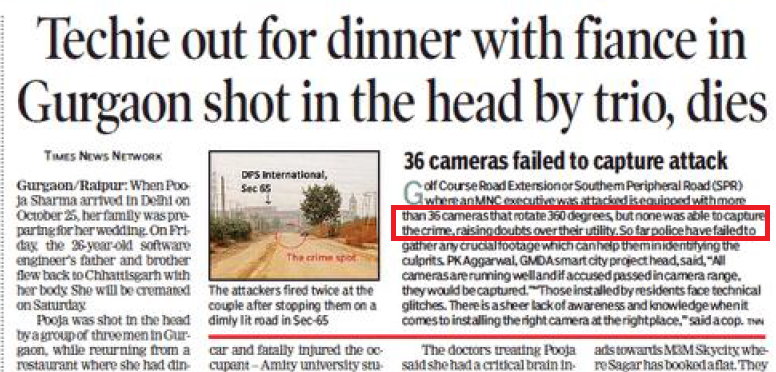
The Times Of India, Mumbai Edition (7th Nov 2020)
Yesterday, I wrote a piece in this very section of this website, which spoke about the importance of correct placement of CCTV Cameras, in order for the solution to be effective!
CLICK BELOW to read that article (4 min read):
Today, I read the newspaper clipping (in pic above) which speaks of a shameful crime that was committed in Haryana yesterday, and an equally shameful CCTV system design that had 36 High Speed Pan Tilt Zoom cameras (which were incidentally working), but failed to capture any relevant data.
Apparantly, even private CCTV cameras that were installed in nearby areas had ‘technical glitches’ and therefor no usable footage was recovered.
I would conservatively ‘guesstimate’ the true commercial value (notwithstanding any unwarranted inflation or escalation, as sometimes happens with Public Sector Projects) of the 36 cameras in question, going my my experience in the field, would be anywhere between Rs. 1 to 1.5 Crores. And there is nothing to show for it. Zilch. The cameras were working. But…..no usable footage.
Why?
I can’t speak for the design of this system in particular, but this is a common problem when systems are put in place purely from a ‘compliance’ or ‘window-dressing’ perspective.
PTZ cameras (as these cameras are commonly known) have some unique strengths, which are ironically also their greatest weakness. These cameras can typically zoom upto a couple of 100 meters away and offer clear, crisp images for recording. They can also be pre-programmed to do what we call a ‘preset tour’, and have, say, a 128 preset positions in multiple zoom/tele combinations, and keep moving automatically and unendingly in a round robin fashion to each of these preset positions. Great, right? Yes, it is! But the weakness that I spoke about earlier is that this very constant motion (the auto-touring) means that only what is being seen by the camera is being recorded. While the cameras move around, there area a lot of areas which are left unmonitored, and thus important footage is often lost!
PTZ cameras are best used in conjunction with some amount of fixed focus cameras. Furthermore, if the synchronization between multiple touring cameras is not choreographed effectively (yes, this can be like a complex dance), then the ‘blind spots’ and far more and far more frequent.
This, it seems, is what happened here. The fact that all the privately installed cameras were also on the fritz once again emphasizes the need for correct audit and review processes.
These points too, were mentioned in my above listed article, which spoke mainly about CCTV placement in a corporate environment. But the fact remains that if CCTV, wherever the deployment, is to be effectively used for protection of life, investment or property, or deployed to deter, thwart or investigate crime, or installed to monitor or manage one person or the public at large, a serious change in mindset is required by all stake-holders.
I hope the Government, the City Planners, the Consultants and the System Integrators are listening.
